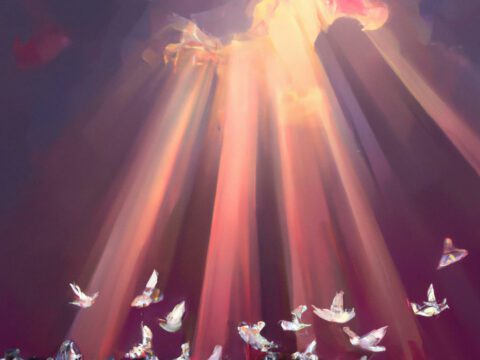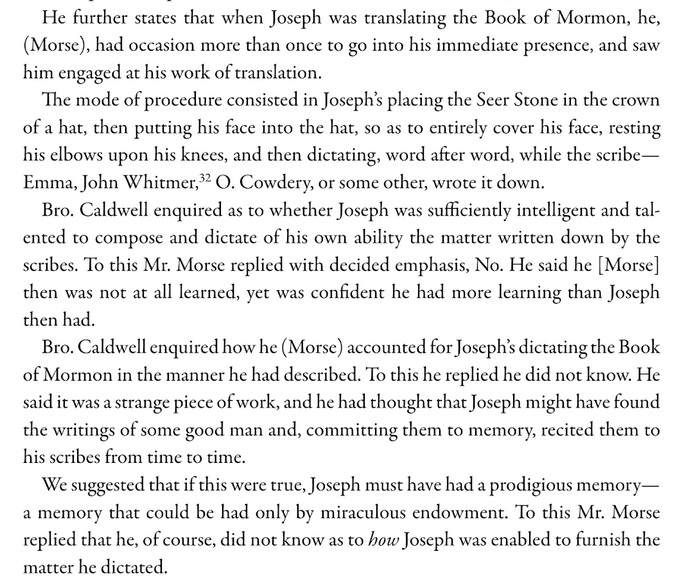It’s no secret that secret combinations are one of the most salient and intelligent aspects of the Book of Mormon. The patterns of behavior and potential dangers in exposed secret combinations, ranging from the Mafia to the Mao Mao rebellion in Kenya or the Triads of Asia, show many elements familiar to the Book of Mormon, including their desire and ability to permeate, influence, or control government. Oaths involving upon the life of someone, even God himself, are part of the pattern of secret combinations that ultimately led to the destruction of two great civilizations in the Book of Mormon.
New insights related to these oaths are revealed in newly proposed Old World word plays in the Book of Mormon. See the latest article at The Interpreter by Matthew L. Bowen “‘Swearing by Their Everlasting Maker’: Some Notes on Paanchi and Giddianhi,”
Interpreter: A Journal of Mormon Scripture 28 (2018): 155-170. An excerpt follows:
From the beginning of the abridged Book of
Helaman, much of Mormon’s remaining narrative history details the
formation, development, and proliferation of oath-bound secret
combinations among the Nephites and their eventual fatal impact on
Nephite society. The common Egyptian lexeme ʿnḫ — which as a verb means “to live” and as a noun denotes “life”1 — also denotes “to swear”2 as a verb and “oath”3 as a noun and constitutes a common onomastic element. Even in its primary meaning, “to live,” the use of ʿnḫ is attested abundantly in oaths during Lehi’s time (cf. the Late Egyptian oath-formula ʿnḫ n=i NN, “As NN lives for me”).4
Thus, the twofold mention of the name Paanchi (Helaman 1:3, 7) in the
immediate context of the first recorded swearing of an oath-bound secret
combination (“swearing by their everlasting Maker,” Helaman 1:11)
among the Nephites emphasizes this moment as a key event in the
ill fated Nephite history. Understanding the semantic range of meaning
for Egyptian ʿnḫ
to include “oath” and “swear” also helps us appreciate the irony
highlighted by Mormon’s inclusion of Giddianhi’s epistolary “oath” as a
failed attempt by the latter to intimidate Lachoneus and his people
into surrender (see especially 3 Nephi 3:8).Thus, both Paanchi and Giddianhi appear to share the Egyptian onomastic element –anchi/anhi/ʿnḫ(i),
and Mormon mentions both names in connection with the rise of the
secret combinations that eventually overtook the Lamanite and Nephite
societies, contributing to the destruction of the latter. Mormon, amid
the decay and collapse of Nephite society, had striking personal
reasons for their inclusion….The Book of Mormon attests the name Paanchi twice (Helaman 1:3, 7). As John Gee has noted,9 Paanchi, as a form of the common Egyptian name p3 ʿnḫ, most plausibly denotes “the living one” (transliterated in Greek as Ponchēs).10 The name “the living one” could have reference to a specific deity (cf. the title, “the living God,” Moses 5:29),11 but also to a person/child who lives (cf. Joseph’s Egyptian cognomen, Zaphnath-paaneah = “The god has said, ‘He shall live’” [paanēaḥ = p3 ʿnḫ], Genesis 41:45).12 Mortality rates — not least infant mortality rates — were extremely high in the ancient world.
In addition to the above, I would here point out that the Egyptian lexeme ʿnḫ (vb. “live,” n. “life”) had additional derived meanings. Perhaps the most important secondary meaning of ʿnḫ as a verb was to “swear” and as a noun it also meant “oath.”
While there is much more meat to be explored in the clever ways Mormon links both Paanchi and Gadianton and Giddianhi to ancient concepts of robbers and their oaths, one thing that caught my eye was the link between the authentic Egyptian name Paanchi. meaning “the living one” and parental hopes that a newborn might survive, discussed in the second-to-last paragraph above. Also see the Book of Mormon Onomasticon on Paanchi:
PAANCHI is quite plausibly the EGYPTIAN name p3-ʿnh first attested in the Thirteenth Dynasty (ca. 1800-1600 B.C.)[1] becoming popular from the Twenty-First through Twenty-Seventh Dynasties,[2] and surviving until Roman times (transcribed into Greek as Ponchēs)[3] The name means “the living one.”[4] (JG). Hugh Nibley has suggested that this is the same name as the Twenty-Fifth Dynasty Pharaoh,[5] although that pharaoh’s name has also been read as Piye.[6]
Paanchi would seem to be a good and hopeful name to be selected by parents worried about high infant mortality rates.
Interestingly, in Brian Stubbs’ work, Exploring the Explanatory Power of Semitic and Egyptian in Uto-Aztecan (Provo, UT: Grover Publications, 2015), one of his over 400 parallels between Uto-Aztecan and Egyptian is item #427 on p. 144, where he finds multiple UA languages sharing a word possibly related to ankh that refers to infants:
427 Egyptian(F) ʕnx ‘to live, v, (living) person, n’:
UACV-141 *onka / *oŋa ‘baby’: I.Num15 *oŋa(a)(’a) ‘baby, child, young (of animals)’; M88-’o15 ‘baby’; KH/M06-’o15: NP(Yerington) oha’a ‘baby’; NP(McDermitt) onka’a; NP oŋa’a ‘baby’ (Snapp, Anderson, Anderson 1982, 20); NP(B) oha’a; Mn ’owaa’ ‘sound of baby crying’; Mn owaa’-cci-cci’ / owaa’-nugu’ ‘baby’; TSh ohmaa(cci) ‘little baby’ (Dayley); Sh ohmaa ‘baby’; Sh pa’ohmaa ‘water baby’; WSh ohaa(cci) ‘baby’; WSh pa’ohaa ‘water baby’; Cm ohnáa’ ‘a baby’; SP oa-C/N ‘young of animals’; SP ïŋaa’- ‘baby’, SP paa-ïŋaa’-ppici ‘water baby’; Ch ïŋa’apici. A medial cluster *-nk- > -ŋ- in NP and SP further lenites elsewhere, Iannucci’s reconstruction *oŋa serving well. TSh and/or Sh have forms with and without -m-, so the -maa forms likely contain another morpheme, perhaps *mara ‘little’. [medial cluster w/hm/hn/ŋ/ø] [e1,e2,e3] [NUA: Num]
Here UACV refers to a dictionary of Uto-Aztecan, and the asterisk in *onka means it is a reconstructed Proto-UA form. Specific UA languages are referred to in abbreviations (see list in my related post on Brian Stubbs’ work) like NP (Northern Paiute), Mn (Mono), TSh (Tumpishia Shoshone), SP (Southern Paiute), Ch (Chemehuevi, a Numic language in Nevada), and WSh (Western Shoshone).
Perhaps Egyptian parents weren’t the only ones who gave a hopeful name like Paanchi to their newborn babes. It would be interesting to see if in UA languages, an ancient “onka” root was also used in personal names.
Also of potential interest is Stubbs’ item 406, p. 142, where Egyptian b’ (ram, soul) shows the same pair of meanings in UA (bighorn sheep, all living creatures) in Proto-UA *pa’aC/ *pa’at (bighorn sheep) and *pa’a (living beings). The occurrences of such double meanings across language families adds to the richness of the proposed relationship between ancient Egyptian and UA languages, for which the number of parallels following regular sound changes already exceed the standards often used to establish common language families among New World languages.
Paanchi looks like an interesting Book of Mormon name whose Old World relationships may have persisted in various forms in UA languages. But did the name itself persist? An interesting question for further exploration, perhaps.
Interestingly, the name Paanchi not only provides an eyebrow-rising example of a clearly Old World name among the Nephites, but the adjacent text in the Book of Mormon suggests an editorial awareness of the meaning of that name as it is employed it in an appropriate way to underscore a key Book of Mormon theme via an apparent word play, as is also done for names of robbers, including a name using the same ankh-related root. It gets even more interesting when we see some traces of these roots in the Uto-Aztecan language family.
It’s surprising how many apparent Old World word plays are present in the Book of Mormon. They typically add to the meaning and increase our understanding of the intent of the authors — in other words, there is explanatory power in the apparent word play. Many have been discovered just in the past two years. The text is rich in such surprises.
Of course, chance alone can create a lucky apparent word play, a stray Hebraism, a random chiasmus, or a blunder of a name like Alma that ends up having archaeological evidence later confirming that it was an authentic man’s name in ancient Israel after all. Here the shear volume and high quality of such occurrences weigh against blind luck. The volume of linguistic connections between each of two distinct varieties of Hebrew and Egyptian with Uto-Aztecan leave little room for random chance, while also fitting patterns with explanatory power, including the power to resolve long-standing mysteries in the study of Uto-Aztecan. The volume of Hebraisms, the richness and vast extant of apparently deliberate chiasmus, and the large number of word plays point to ancient origins that simply cannot be dismissed as a bullseye’s drawn around a few random targets that hit something. Just the recently discovered word plays identified by Matthew Bowen at The Interpreter, often abounding in detail and explanatory power, offer a treasure to contemplate. But there are others as well. It’s a field worthy of reflection and much more research.












Once again the Texas sharpshooter finds a stray bullet hole, draws a circle around it, and triumphantly cries out, "Bulls-eye!"
— OK
This is such a good catch Jeff!
Anon;
Did you read in detail Jeff’s last paragraph before posting?
Did you read in detail Jeff’s last paragraph before posting?
Yes, I did, Darren. And Jeff's assertions in that paragraph are wrong.
— OK
I guess "high quality" doesn't mean what I thought it meant, Jeff.
… chance alone can create a lucky apparent word play, a stray Hebraism, a random chiasmus….
— Jeff Lindsay
As a dog returneth to his vomit, so a fool returneth to his folly.
— The Book of Proverbs
For the umpteenth time: in a text written by someone who, like Joseph Smith, is imitating the style of the Bible, the appearance of Hebraisms or chiasmi can generally be explained as products of the imitation, not as random or miraculous.
Anyone who hopes to be taken seriously should knock off this sort of knee-jerk "chiasmus" hackery.
— OK
Once again the MesoAmerican theory is pushed by Mormanity. Keep ignoring the Scriptures!
Secret combinations are dangerous according to the BofM.
Secret combinations ARE dangerous.
Yet too many Mormons support organizations that are secret combinations, belong to secret combinations…. especially the First Presidency and Q12.
No wonder the Mormon church is under condemnation by God.
Keep ignoring the Scriptures!